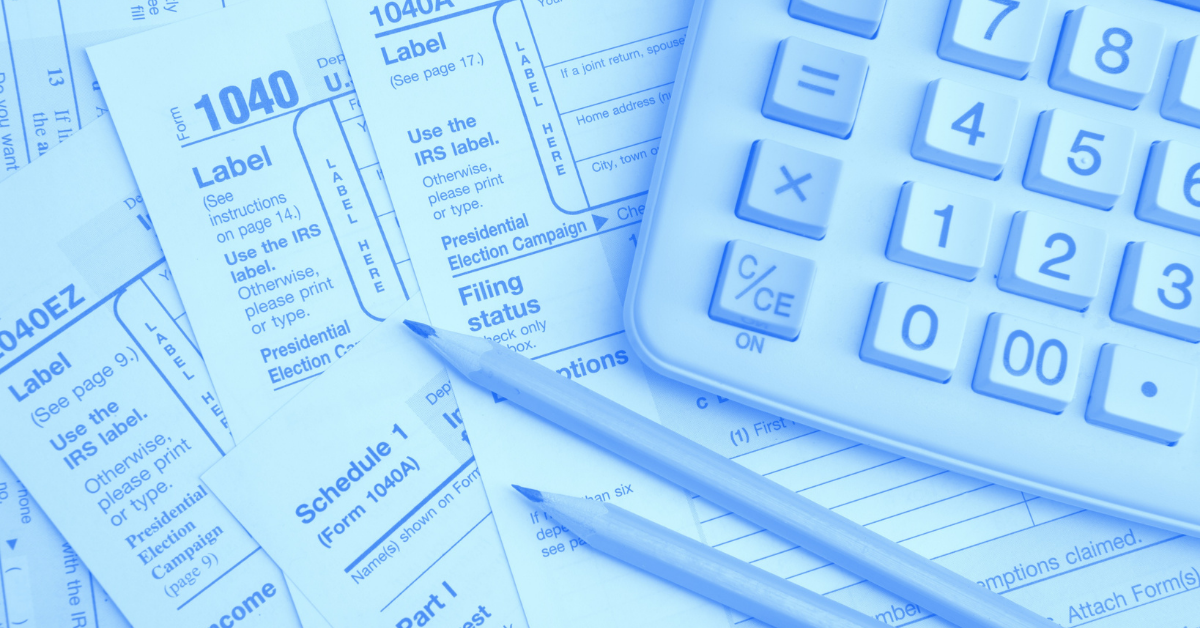.png?width=554&name=Copy%20of%20BLOG%20IMAGES%20TEMPLATE%20(21).png)
15 MIN READ
Tax planning strategies are an essential component to maximizing retirement income. And the more income you have, the more you get to spend or pass down to your heirs. There are a lot of retirement tax planning articles out there. But our goal is to provide more of a “how-to” so you aren’t just relying on someone else’s word. So we’re going to explain the importance of retirement tax planning – 6 things you must know.
Anytime I am at a social gathering and people find out I’m a financial planner, the response is always an inquisitive, “oh?” I can see them scrambling through their brain trying to think of a financial question for me. As you can guess, I’ve had some really interesting conversations with strangers. Some of the most common questions I get are:
“What will my tax rate be when I retire?”
“Will my Social Security Benefits taxed?”
“How can I plan ahead for retirement?”
You’re going to get answers to these and many other questions by the end of this article.
How Much Income is Needed in Retirement?
Whether you work with a financial planner or not, a successful plan starts with you. You and only you have to decide on what your life in retirement will be.
If you’re anything like me, you are going to want to know how often you can dine out. Or how many weeks you can live abroad every year. Or….maybe you just want to order that $4 side of guacamole and without feeling guilty.
The point is that the first step is to figure out how much we need to spend. And that is unique to each of us.
Creating Your Personal Financial Statements
So now that you know what you need to spend in retirement, it’s time to figure out how to make it happen. You are going to want to know how much you need to withdraw every year…and where to draw it from.
Your balance sheet is the first financial statement you will need. It contains a list of your assets and liabilities in separate columns. The difference between these amounts is your net worth.
Then you will list your annual income and expenses on your personal income statement. The difference between these amounts is your income shortfall.
Think of your net worth like your water well and your income shortfall as the water. You have to make sure there is always enough water in the well or you’ll go thirsty. Or in our case, you risk outliving your assets.
Income Needs Will Increase Over Time
One of the biggest obstacles for retirees is inflation. Every year the cost of goods and services increases. Luckily, Social Security benefits have a cost of living adjustment (COLA) to help keep pace.
But if you have a private pension, there may not be any COLA included. That means that your income will purchasing power over time.
As you can see from the chart, inflation has averaged over 2% over the last 20 years. It’s a lower rate than the historical average of 3.1% since 1913. But it still takes a big bite out of your purchasing power over time. Something that cost $100 in 1913 would cost $2,555 now! That’s why it’s important to know how much you need to spend now and in the future.
Something that cost $100 in 1913 would cost $2,555 now! That’s why it’s important to know how much you need to spend now and in the future.
How Much of Your Income Will be Taxable?
The good news is that it’s all up to you. The bad news…um yeah, it’s all up to you. You have nearly full control of your income decisions in retirement. The goal is clear: to maximize your income while paying the least amount of tax.
The first thing you need to know is how our tax system works. You’re going to have to know Social Security and retirement account rules. There will also be plenty to know about tax-efficient investing.
But that’s why you’re here in the first place, isn’t it? So let’s start with some retirement tax planning basics: how taxes in retirement work.
How Taxes are Calculated
Ordinary Income Tax Rates
Our federal income tax system is progressive. That means that the percentage of tax increases along with income levels. Ordinary income can consist of wages, salaries, and interest. But more concerning for retirees are taxable Social Security benefits and IRA withdrawals.
We all pay federal taxes starting at a rate of 10%. The federal marginal tax brackets go all the way up to 37%. If you look at your most recent tax return, line 10 on schedule 1040 gives you your taxable income. Looking at the table, you can see which marginal tax bracket that number puts you in.
Any extra dollar that’s earned will be taxed at your marginal tax rate. As an example, let’s say a single-filing taxpayer has taxable income for the year of $40,000. They are close to going from the 12% marginal tax bracket to the 22% bracket. But their bank account is running low and they need another $30,000 for living expenses.
If they take the $30,000 needed from an IRA account, the entire amount counts as ordinary income. That means they pay federal income tax at a marginal tax rate of 22%. Keep in mind that this does not include state income taxes (depending on your state of residence).
If you withdraw the $30,000 from a Roth IRA or taxable account you could avoid the extra tax bill. So you need to think twice about where your income will come from each year.
 Capital Gain Tax Rates
Capital Gain Tax Rates
Favorable capital gain tax rates are a key retirement tax planning tool. When you sell a capital asset for more than what you paid for, the result is a capital gain. Capital assets include stocks, bonds, real estate, precious metals, cryptocurrency, etc.
If you sell a stock for a profit and hold it for one year it is taxed as a long-term capital gain (LTCG) as shown in the table. You can see that these rates are always lower than your marginal tax rates.
If you sell a capital asset for a gain that was held for less than a year, the gain is taxed as ordinary income. This is called a short-term capital gain (STCG) and will be subject to your federal marginal tax rate.
What if you sold a capital asset at a loss? In that case, here is how you would treat the loss:
List all your realized short or long-term losses
Offset short-term gains with short-term losses
Offset long-term gains with long-term losses
Finally, compare your net long-term gain/loss vs. your net short-term gain/loss
Here is how the results are treated:
A Net LTCG – taxed at long-term capital gain rates
A Net STCG – taxed at your marginal income tax rate
And if there is a net loss? Whether short or long-term, you can use $3,000 of the loss as a deduction in the current tax year. The remaining losses carry forward indefinitely. They can be used to offset gains in future years. In years with no gains, you can always use up to $3,000 of your carryforward losses as a deduction against your ordinary income.
Withdrawals from Retirement Accounts
Retirement account withdrawals are where you can save BIG on taxes in retirement. This is where all that prudent saving you did in your working years pays off. Without an income distribution plan, you can kiss a lot of those savings goodbye to taxes. But not you. You are going to use your newly acquired retirement tax planning skills to turn the tables in your favor.
Taxable Accounts
Taxable accounts are any non-retirement accounts. Think of your bank or brokerage accounts or that stock certificate your granny gave you as a kid. For married couples, these accounts are usually jointly owned or in the name of their trust.
The capital gain rates that we discussed earlier apply to assets owned in these accounts. In your taxable account is where you need to pay attention to the cost basis and holding periods.
Qualified dividends from stocks held in a taxable account are also taxed at lower capital gain rates. But interest income held in a taxable account will be treated as ordinary income, along with STCG’s.
As you can see, a sale of an asset here can be subject to two different tax rates. As can the income an asset produces, dividends and interest. And with capital loss rules at your disposal, you can save yourself a lot of money with a good investment strategy. More on that later…
Tax-Deferred Accounts
Tax-deferred accounts are the most common types of retirement accounts. Think of 401k’s, 403b’s, IRA’s, and pensions. Every time you contributed to these accounts, that money avoided taxation.
There should be a lot of growth from compounding if you have invested it well. But you see that number at the top of your statement that says “Account Value?” That’s not all yours. No, you have a silent partner named the IRS that is waiting for your distributions to begin.
And when they begin, they taxed at the highest rates. So you want to be extra careful when making withdrawals or rollovers from these accounts.
 Tax-Free Accounts
Tax-Free Accounts
Roth IRA’s and Roth 401k’s are the only retirement accounts that provide tax-free distributions. Roth accounts are funded with after-tax contributions, so no immediate tax benefit is received. in exchange for that immediate benefit, all the growth in the account is tax-free.
A Roth is a great account to have in retirement because they allow you to spend more without climbing into a higher marginal bracket. So when you find out you need a new roof, you won’t have an extra tax bill to make things worse.
Every year you should calculate your income needs and tax bracket and then choose the most efficient withdrawal strategy. When your nest egg consists of all three types of accounts, you have what we call tax diversification. It is the foundation of your retirement tax planning strategy.
Will Your Social Security Benefits be Taxed?
Social Security is a big part of most American’s retirement income. It is also very complex and takes some careful analysis to ensure you are making the best decision. Next, we’re going to focus on three tax-related factors that impact Social Security Benefits.
When You Should Take Social Security Benefits
Take a look at your most recent Social Security Benefit statement or view it by logging in to your account. Find where it states your benefit at full retirement age (FRA). This is the age that you can begin receiving your full benefit. On your statement, you can also see a reduced benefit if you take it at age 62. You can also delay to age 70 for a higher benefit.
Take it at your earliest age and you face a reduction in benefits of over 25%. But delaying it allows it to grow at about 8% per year. There aren’t many things you can invest in and get a guaranteed 8% return! However, when you should take it depends on how much you have saved as well as health factors. And of course, how much tax you will pay on your benefit.
Taking Social Security While Working
This is quite fine as long as you start your benefits at your FRA. But if you are under full retirement age for the entire year, your benefit is reduced by $1 for every $2 you earn above the annual limit. For 2021, that limit is $18,960. In the year you reach full retirement age, your benefits are reduced by $1 for every $3 you earn above a different limit.
In 2021, the limit on your earnings is $50,520. Your earnings are counted up to the month before you reach your full retirement age, not your earnings for the entire year.
How Your Social Security is Taxed
Your Social Security income is either 0%, 50%, or 85% subject to taxation. In other words, if your benefit was $30,000 and 50% was taxable, then $15,000 would be added to your ordinary income. Subject to – you guessed it, your marginal tax rate. The key factor in determining how much is taxable is your other sources of income as you can see from the formula below.
Since half of your Social Security benefits are included in the calculation, most of us will pay tax on about 85 percent of benefits. Here are the Internal Revenue Service (IRS) rules. If you:
file a federal tax return as an “individual” and your combined income is between $25,000 and $34,000, you may have to pay income tax on up to 50 percent of your benefits. More than $34,000, up to 85 percent of your benefits may be taxable.
file a joint return, and you and your spouse have a combined income that is between $32,000 and $44,000, you may have to pay income tax on up to 50 percent of your benefits. More than $44,000, up to 85 percent of your benefits may be taxable.
are married and file a separate tax return, you will probably pay taxes on your benefits. In summary, the timing of your Social Security benefits is a huge part of controlling taxes in retirement. To oversimplify, you want to keep as much of your benefit in your pocket.
There is a lot of thought that goes into selecting the right Social Security strategy. It’s a balancing act between maximizing your benefit and protecting it from taxes. Social Security and pension benefits must always factor into your retirement tax planning decisions.
Retirement Tax Planning Strategies
You should now have a good idea of how our tax system works and how to create retirement income. You now have some great tools to reduce your tax bill! But, there is still so much more you can do…
Plan for RMD’s
Employer-sponsored retirement plans are the primary retirement savings vehicles for retirees. One reason is that the contribution limit is much higher than that of IRA’s.In 2021, the contribution limit for a defined contribution plan is $19,000 per year. In contrast, the annual IRA contribution limit is only $6,000.
These accounts are where most Americans have saved their nest egg. And as we mentioned earlier, the IRS wants to collect its share of the pie. So at age 72, you must begin taking Required Minimum Distributions (RMD’s) from these tax-deferred accounts. And the penalty for not taking your RMD is 50% of the amount!
A big mistake that many people make is not planning ahead for RMD’s. When you add that income to your other retirement income sources, it can easily put you in a higher marginal bracket.
It typically isn’t a good strategy to avoid distributions from your tax-deferred accounts. It may make sense to take some out during years when your tax bracket is extremely low. This ensures the income is taxed at lower rates.
Convert to a Roth IRA
Another great retirement planning strategy is Roth Conversions. It consists of transferring money from your Traditional IRA to your Roth IRA. The entire amount is treated as ordinary income just like a distribution.
But the benefit here is converting at tax rates that you know are less than or equal to future tax rates. If you retire at 60, you probably don’t have any fixed income sources. This is when your marginal tax rates are usually the lowest. It may make sense to pay tax now and allow for tax-free growth going forward.
Roth Conversions also reduce your tax-deferred balance, which lowers future RMD’s. Lastly, they help your wealth transfer strategy since beneficiary withdrawals are also tax-free.
Contributions to Retirement Plans
It’s very common for one spouse to continue working after the other retires. This can present the opportunity to contribute to their 401k or other employer plans.
They could also be eligible to make Traditional or Roth IRA contributions for themselves and their retired spouse. Yet another tool to lower your income or contribute more to tax-free accounts.
Charitable Gifting in Retirement
There are several ways to give to charities and reduce taxes. You can give away your RMD through a qualified charitable distribution (QCD). You have to be age 72, but you won’t have to report RMD income using this strategy.
Gifting highly appreciated stock is another common tax reduction strategy.
It allows the taxpayer to avoid paying capital gain tax.
A donor-advised fund is another way taxpayers can give charitably and get a tax break.
Invest Tax-Efficiently
Earlier, we stated that income from taxable accounts can be taxed at ordinary income or capital gain tax rates. There are a lot of portfolio management strategies you can use to control taxes. If you work with a financial advisor, don’t be shy in asking how they are managing your portfolio.
Tax-Efficient Investment Vehicles
Mutual funds are professionally managed investment vehicles that provide market exposure. There is a fund today for any asset class you can think of – like the Proshares Pet Care ETF (PAWZ).
But when it comes to selecting funds, you first need to know if you are investing in an active or passive fund. Not only are they higher in cost, but most active funds are not tax-efficient. The manager is buying and selling positions throughout the year.
This turnover can generate capital gains that you have to pay tax on. As a matter of fact, your fund could have an unrealized loss for the year and still distribute capital gains!
Index funds and ETF’s focus on tracking a benchmark. An example of a benchmark is the S&P 500. Since these benchmarks have minimal turnover, the respective funds also have low turnover. Investors also benefit by paying much lower expense ratios in passively managed funds.
Depending on your tax bracket, municipal bonds can also make a lot of sense in taxable accounts. These are state-issued bonds that provide state and federally tax-exempt interest. To qualify, you must reside in that state of issuance. They pay lower interest than taxable bonds, so you have to do some math to see if they fit in your portfolio.
Tax-Loss Harvesting
When you buy an asset in a taxable account and you sell it for a gain, you pay capital gains tax. And you know now that 1 year is the holding period that determines whether it is short or long term.
Since you need to liquidate securities frequently in retirement, it’s important to use capital losses wisely. Tax-loss harvesting does just that by using market volatility to your advantage. It’s best to use an example to explain it.
Let’s assume you invest $50,000 in a fund and the market subsequently declines, decreasing your fund’s value to $40,000. You don’t want to panic and sell it and go to cash. And you can always just ignore it and wait for the markets to bounce back.
Or you can sell the fund and immediately purchase a substitute fund in its place. This way, you can still recover your $10,000 paper loss. But since you sold your initial investment, you have now created a capital loss.
Going back to our capital gain rules, you can use the loss to offset gains in the current year. If there are no gains, you can carry forward the losses. And you can deduct $3,000 of losses every year against your ordinary income. For large taxable account balances, tax-loss harvesting is a popular retirement tax planning tool.
Asset Location
Asset Allocation is the process of investing in different asset classes to balance risk/reward. This means selecting the right weighting of stocks, bonds, and other asset classes in your portfolio.
But you may have never heard of asset location. This strategy involves determining which accounts should hold each asset class. The goal is to maximize after-tax returns and it works like this…
If you have all three types of accounts and you could pick where you want the most growth, which would it be? Well, we know that Roth accounts will provide tax-free distributions. So it would make sense to hold your high-risk/return asset classes in Roth accounts.
Then it also makes sense to hold low-risk/return asset classes in accounts with the highest tax rate. Of course, this is to keep your ordinary income lower in retirement. Bonds for example are great to hold in tax-deferred accounts.
And we already discussed many of the benefits and strategies to help control taxes in taxable accounts. Even if you only have two types of accounts, asset location is still key to your after-tax investment returns.
Retirement Tax Planning Summary
Give yourself a nice pat on the back if you’ve made it this far! We threw a lot of information at you readers and you may feel a bit overwhelmed. But now you can start planning your retirement today!
The first step is to really think hard about what your retirement will look like. This will give you the answer to a key variable – how much income you need. Next, you need to get familiar with how the U.S. tax code works.
You also need to decide on Social Security and retirement account withdrawal strategies. Not to mention making sure your financial advisor is managing your portfolio in the most tax-efficient manner. Lastly, don’t miss out on any other tax-planning strategies like Roth Conversions or charitable gifting.
Taxes are at the center of all of your retirement planning decisions. If this part isn’t clear to you, we highly recommend you get the help of a fee-only financial planner or other tax professional.
You only retire once. The less tax you pay, the more resources you have for a rich, fulfilling retirement.
 About the Author
About the Author
Retirement requires making decisions that will impact you for the rest of your life. As a Certified Financial Planner™ and a Registered Life Planner®, Danny provides transparent retirement planning advice that is always in his client's best interests. Satori Wealth Management does not accept commissions or fees from third parties to remove any conflict of interest.
For 20 years,Danny has led clients through the maze that is retirement planning and he loves knowing that his clients are fully enjoying this phase of their lives and not worrying whether or not their financial resources can support their most fulfilling retirement.
Did you know XYPN advisors provide virtual services? They can work with clients in any state! View Danny's Find an Advisor profile.
.png?width=554&name=Copy%20of%20BLOG%20IMAGES%20TEMPLATE%20(21).png)
 Something that cost $100 in 1913 would cost $2,555 now! That’s why it’s important to know how much you need to spend now and in the future.
Something that cost $100 in 1913 would cost $2,555 now! That’s why it’s important to know how much you need to spend now and in the future.  Capital Gain Tax Rates
Capital Gain Tax Rates Tax-Free Accounts
Tax-Free Accounts
 About the Author
About the Author





